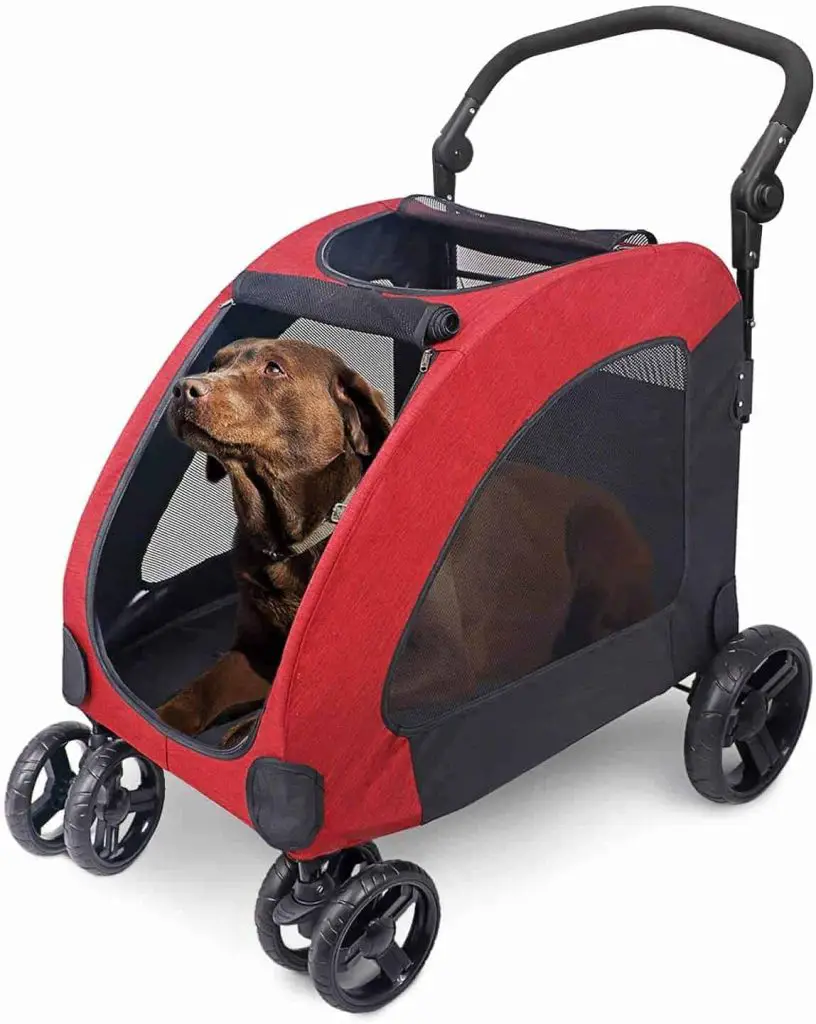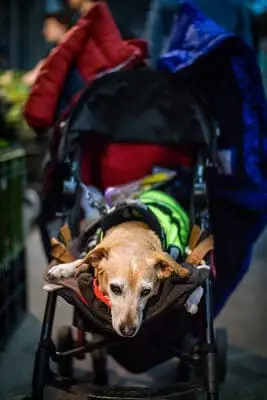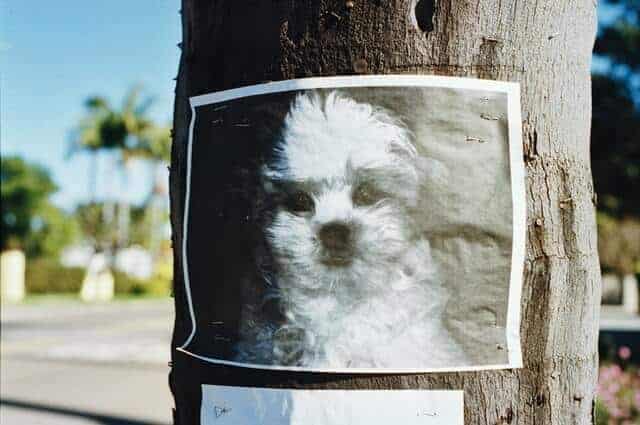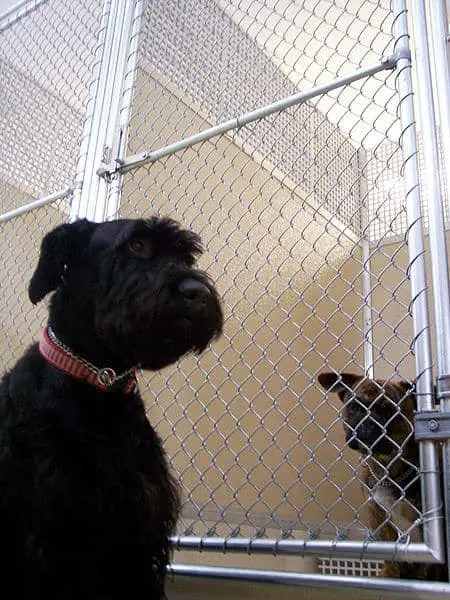Can I put my dog in a baby stroller?
Dog parks are filled with all types of people and their canine companions. If you enjoy a spot of people watching then there is almost no better place to sit down and gaze upon the eclectic mix of owners and pets and remark on their similarities and differences. Young nuclear families with a perfectly turned out children might have an equally perfect looking Golden Retriever happily playing fetch with a frisbee. Another professional-looking woman in a navy suit could be having an animated conversation with a hands-free device while her pedigree Boston Terrier trots along beside her at a swift pace. A little further along you see an elderly grandmother lovingly pushing her grandchild in a baby stroller towards you. As she sits down beside you, you quickly take a sneak peek inside expecting to see an angelic baby but instead, to your surprise, you find that the stroller’s occupant is a perfectly coiffed Yorkshire Terrier.
It is possible to put your dog in a baby stroller, and there are various reasons why a person might resort to a baby stroller as a form of transport for their pet. However, just because something is a possibility, doesn’t mean that it is a safe and effective form of transport for your pet.
It seems that more and more dogs are being strolled around in expensive looking prams rather than walking on their own four paws as nature intended. A pampered pooch in a stroller seems to defeat the purpose of taking a dog for a walk in the first place since they aren’t getting any exercise. Some might even comment about how owners are increasingly treating their pets like fashion accessories or humanizing their dog and calling them their ‘fur baby’. The humorous sight of having your dog in a baby stroller often has deeper reasoning of ensuring the well-being of the owner, the dog, or both and as such, people should not be quite so quick to judge.
In this article, we will discuss why you should not use a baby stroller for your dog. In addition, we will elaborate on the reasons that a person might feel that using a baby stroller for their dog is the right decision for their situation. If you still feel that your dog will benefit from using a stroller, we will explain how best to get your dog sensitized to using a stroller for their next loop around the block.
Why you shouldn’t put your dog in a baby stroller
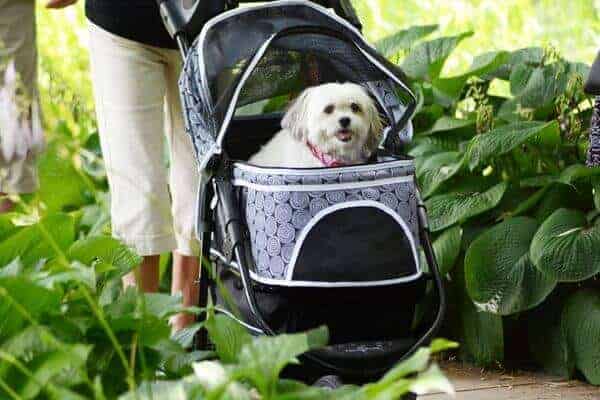
Baby strollers are designed for (drumroll please) … human babies. If you have an unused baby stroller, then you may benefit from financial savings by using a baby stroller for your dog. However, there are several reasons why you shouldn’t put your dog in a baby stroller which we will elaborate on below.
Design – Baby strollers come with a high price tag that reflects the extensive investment into safety, design, and engineering for newborns, babies, toddlers, and small children. The purpose of a baby stroller is to safely transport a baby, not a dog. At no point during the safety testing for a baby stroller is testing done to confirm the safety of a dog as this is the purpose of a baby stroller.
Safety – Baby strollers are designed to be safe for human children and much time and investment is dedicated to this aspect. The functionality of the harnesses and straps are such to ensure the security and safety of a baby or child. A dog cannot fit into the safety harnesses of a baby stroller and therefore can leap out without warning which can cause serious and irreparable damage to your lovable canine. A baby stroller is also designed in such a way that a child can get the maximum view of their environment; however, this may not be appropriate for an anxious or defensive dog that needs the feeling of safety and protection that a screen mesh cover of a more traditional dog stroller can provide.
Purpose – A baby stroller is designed for the weight distribution of a sitting child, and not for a dog which sits in a completely different position. As such, a baby stroller can become easily unstable and tip, particularly if the dog becomes agitated and moves about. Moreover, a dog does not naturally sit for periods but generally prefers to curl up and lie down which they would probably not be able to do in a baby stroller.
Baby strollers are not designed for dogs and should not be used for this purpose. It is unsafe to use a baby stroller or baby pram for your dog and may result in a great deal of unnecessary harm and emotional distress for your beloved pet. There are good quality dog strollers on the market which are surprisingly reasonable in price and fit for purpose. Keep reading see why you might want to consider purchasing a dog stroller for your dog and how to get your dog accustomed to using one.
When would a person put a dog in a stroller?
There is a common school of thought that a dog is happiest and healthiest when they are down on all fours and able to explore their surroundings. Just the sight of a leash or the utterance of the word ‘walk’, even if taken out of context, can turn the calmest canine into a frenzy of excited and bouncing fur. A stroller for your dog might seem counterproductive to your dog’s need and desire for exercise; however, there are times where a stroller is very useful. Below we have outlined some of the situations and contexts when a stroller can be a very useful investment for you and your dog.
In Traffic – If you live in an urban area, then traffic is likely a real concern. You may be worried that your dog will bolt into traffic, or a rogue car, bicycle, or pedestrian will not see you and your small pup. A stroller can assist with ensuring the visibility and safety of you and your dog.
For Vet Visits – An outing to the veterinarian can be a stressful time for both you and your dog. You may be worried about your dog catching germs from other animals in the clinic, or about their socialization skills with other pets. A dog that is sick or recovering may not be good with unfamiliar environments and people. If your dog tends to chase every cat in sight, then a vet trip can be particularly hazardous. Having your dog in a stroller will alleviate many of these worries and allow your dog to be in a comfortable, safe environment. If you have a little of puppies then you may also consider using a stroller to ensure the pups are secured and none escape while exploring.
When Travelling – If your family likes to travel then a stroller can be even more useful than a crate for giving your dog a consistent place to rest in unfamiliar terrain and locations.
While Shopping– Many malls or shops would not allow you to enter if your dog was on a leash but would be lenient if using a dog stroller. Also, a dog stroller has areas that have been purposefully designed to keep additional items that can be useful for small amounts of shopping.
For Anxious dogs – Sensitizing your dog to public spaces can be a long and difficult process, especially if they are getting over past emotional or physical trauma. A stroller can help to ensure that both your dog and those around them, stay safely separated and can be used as a tool for working towards social confidence.
If you have two dogs or more – Walking two or more dogs at the same time takes serious skill and organization. Any dog walker that has had dogs bolting in opposite directions or leashes precariously wrapped around their legs knows what we are talking about. This situation may be compounded if your dogs are of markedly different sizes or abilities, then you might want to put one pet in a stroller while the other continues getting their exercise requirements.
During Extreme Weather – Both hot and cold extremes of weather can require protecting your dog’s paws; hot tarmac can burn their sensitive paws and icy terrain often involves salted areas that dry their paw.

Why would a dog need to go in a stroller?
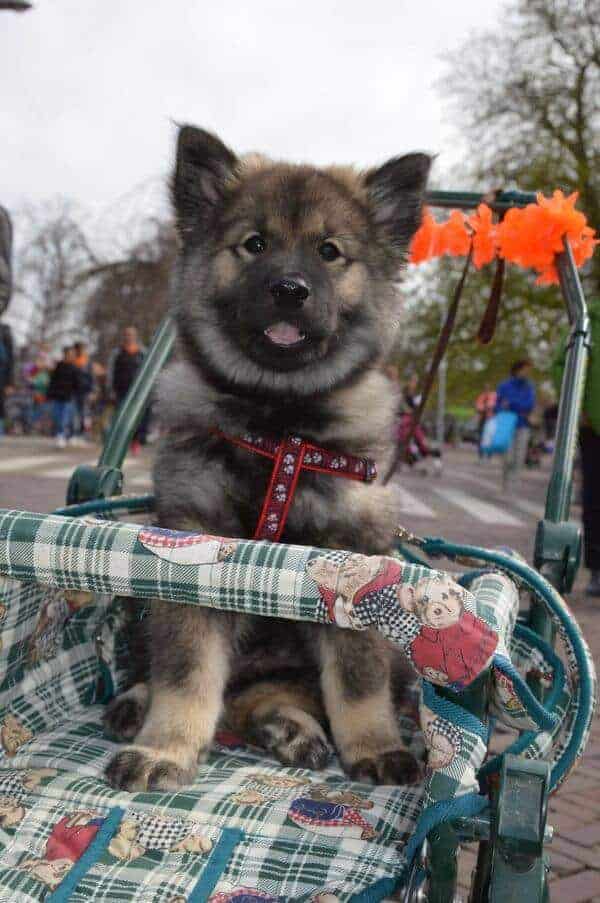
People can be quick to judge but there are a variety of reasons that a stroller may be needed to keep a dog, and their owner safe while being able to take advantage of a lovely stroll out in good weather. We have so far discussed when a stroller might be useful for you and your dog but we have yet to discuss why someone might need a dog stroller. The following are a few of the reasons that an owner might feel the need to use a baby stroller for their dog.
It doubles as a dog crate – We are big advocates of crate training. A dog that has been crate trained well will not see their crate as a punishment but in fact as a comfortable and consistent place of respite. A dog should happily go to their crate to rest and not need to be forced in.
People with mobility issues – Carrying a dog whether just in your arms or in a cumbersome pet crate can be exhausting or even impossible for some people. A pet stroller, by design, is mobile though has the benefits of a dog crate. Taking a dog for a long walk on a lead may also prove difficult for physically impaired or elderly persons so a stroller can assist in this regard.
Runners – One of the best parts of having a dog and being a runner is having someone to come along with you for company and safety. However, young dogs, especially large and quick growing ones, should not be exercised too much at a young age. Small, elderly, or injured dogs may not be able to keep up with a rigorous pace, so a dog stroller can be very useful.
Dogs with mobility issues – Elderly dogs, injured dogs, paralyzed dogs and sick dogs all deserve the chance to get out of their home environment and stimulated by the sights and smells of a walk; however, for a variety of reasons they may not be able to go far or walk at all. A stroller can enable them to keep up with their loved routine while not causing further injury or distress.
Unvaccinated puppies – The first three months of a dog’s life are crucial for training and socialization. Walks are excellent for being able to get puppies used to new sights, smells, and people while ensuring that they do not catch any diseases that they are yet to be vaccinated against.
How do you teach your dog to go in a stroller?
Some dogs will take to a dog stroller like ducks to water whereas others may be more naturally nervous and take time to adjust. Regardless of the temperament of your dog, the training and sensitization process will be the same for teaching your dog to go into a stroller, it is just the length of time to get them comfortable that may change.
Get them used to seeing the stroller – Set up the stroller and keep it in an area of your home that your dog is likely to go to several times per day. Once they are used to seeing the stroller as a part of their daily life, then integration will become much easier.
Take them for a walk with the stroller – If you and your dog are physically able, take them for a short walk with an empty stroller. This might sound counterproductive but all that you are trying to do in the beginning is get your dog used to the sight, smell and sound of the stroller so that they are as sensitized as possible.
Start to reward your dog by the stroller – We all love treats and rewards. Start to give your dog small treats and lots of affection while in the vicinity of the stroller. Consider putting small treats actually on the stroller in areas where your dog could comfortably and safely reach but remember to keep the brake on! Continue with providing a lot of affection when your dog goes close to the stroller.
Pick up your dog and put them in the stroller – Do not rush to get to the point of picking up your dog and putting them in the stroller. You first want to ensure that they are very comfortable and expect to get plenty of positive reinforcement, in the way of treats and cuddles, when around the stroller. If you think that they are ready, then pick up your dog and put them in the stroller. Having a special soft toy or blanket in there may help with feeling that this is ‘their’ new space. Make sure that you have a comfortable grip on your pooch so that there is no threat of them jumping out and harming themselves. If they seem frightened or anxious, then offer a treat and plenty of affection but only keep them in the stroller for a short time. This stage may take a while until your dog is comfortable being in the stroller, and you do not have any fear of them panicking and jumping out.
Take the first venture out – If you have a garden or back yard, then we recommend first taking short walks around an area that your dog is very familiar with. Alternatively, you can start by pushing your dog around the inside of your house a few times until they are used to the movement and being at a different height advantage.
Get out and about – Once your dog is comfortable with all of the previous steps, it is time to get both of you out for a well-deserved stroll around the block. Ideally, start in a route that is very familiar to your dog so that they can take in the sights and smells that they know and recognize. When you are both more used to the arrangement then feel free to get out for as long as you please, as now the only thing holding you back from an extensive walk is your own physical willingness and ability.
